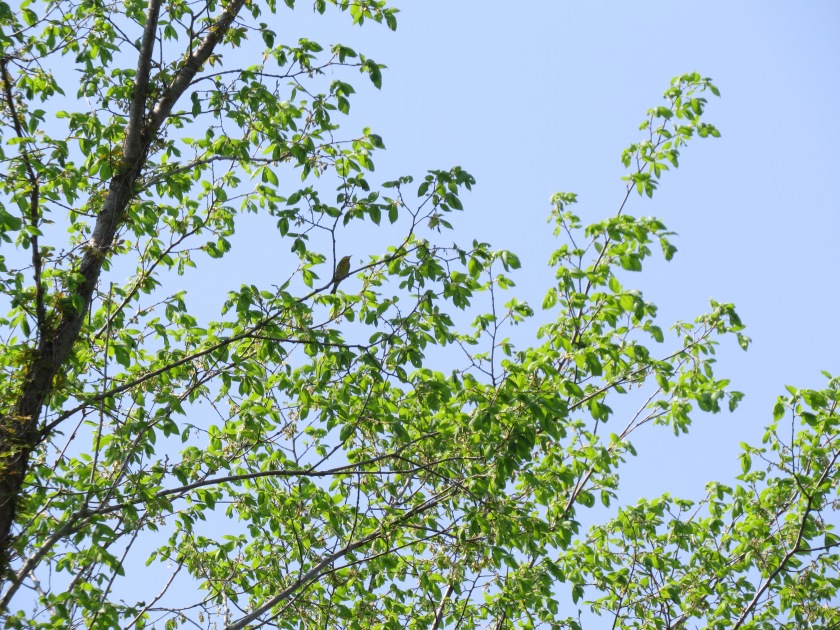
By Bruce Stambaugh
Like children dreaming of Old St. Nick on Christmas Eve, this is the time of year birders have yearned for, longed for, relished.
For hardcore birders, spring migration is a Christmas morning that spans several weeks from mid-March to mid-May. Avid birders are especially on the alert now to find the many species they seek, and some they couldn’t even imagine.

Such birds are the exception. The spring migratory norm is to view birds that either return here to nest or to catch a glimpse of those that are just passing through. Depending on the weather, the transients might stay a day or two, or just make a short pit stop to rest and refuel.
The challenge is to be at the right place at the right time to see and hear the birds.
For me, I’m just as happy to note the return of my backyard birds. The Chimney Swifts rattled the fireplace doors as they swooped into our chimney the evening of April 18, the same date as last year.
How do I know? Like most birders, I keep a list of when I see a species for the first time each year. In the birding world, that’s known as the FOY, first of year. For instance, the Red-headed Woodpecker was a day later than last year, arriving April 21.
Today’s birders use social networking sources to track the movement and appearance of the various species. That gives the flocks of birders a heads up on finding and photographing particular birds.
We are fortunate in Ohio to have one of the best locations in the country to observe and hear a wide variety of transitory and returning birds, especially warblers. This time of year both birds and birders pack Magee Marsh Wildlife Area.
A conservation group, the Black Swamp Bird Observatory, located at the entrance to Magee Marsh in northwest Ohio, sponsors “America’s Biggest Week in Birding.” In fact, it’s going on right now.
These folks welcome thousands of birders, amateur to professional, in hosting this attractive annual festival. Magee Marsh, a state park, is billed as “the warbler capital of the world.” Having been there on many occasions, I can attest to that.
Birders from around the world converge on Magee Marsh just to watch the warblers and shorebirds come and go. It’s not unusual to observe 20 or more kinds of warblers in just a few hours. Magee Marsh and the surrounding acreage are protected habitat that ensures safe harbor for migrating and nesting birds of all sizes, colors and species.
My first visit to Magee Marsh years ago was indeed like Christmas. A few steps onto the wooden boardwalk and I spotted a variety of colorful warblers decked out in their impressive breeding plumage. The brightly colored little birds looked like Christmas tree ornaments perched on low-hanging tree branches.
Where I live here in Ohio’s Amish country, we don’t necessarily have to drive that far to enjoy the migrating birds. The Killbuck Marsh Wildlife Area, the Holmes County Trail, The Wilderness Center, and the many ponds and lakes in our area provide excellent habitat for a variety of birds.
Or you can just step outside and watch and listen. You just might think it’s Christmas in springtime.

© Bruce Stambaugh 2015









Absolutely fascinating! I can see why you love birding.
LikeLike
Thanks, Gail.
LikeLike
Oh I would love to see Ohio’s warblers! I had no idea it was a warbler haven.
LikeLike
Just go to your nearest park, and you should hear and see some warblers, Ava.
LikeLike
I live in Northern New York and I’m currently playing a Dawn Song CD early every morning trying to attract newly nesting Purple Martins to our martin housing unit that we put up last year. I do so HOPE that they nest with us this year.
LikeLike
Bonnie, I hope you’re successful, too. Martins are pretty particular in their nesting location. Is your Martin house in the open, away from trees? Is there water nearby? Are there places for them to perch?
LikeLike
We followed all the rules for placing the new house. Yes it is near a creek, and yes it is out away from the trees in the open with a garage nearby. Our instructions said they like to be about 30 feet from a building as they like to be near people. We also keep the area clean of brush and vegetation so critters can’t sneak up on them. The Amish in the nearby town have lot of martins and we talked with them before setting ours up.
LikeLiked by 1 person